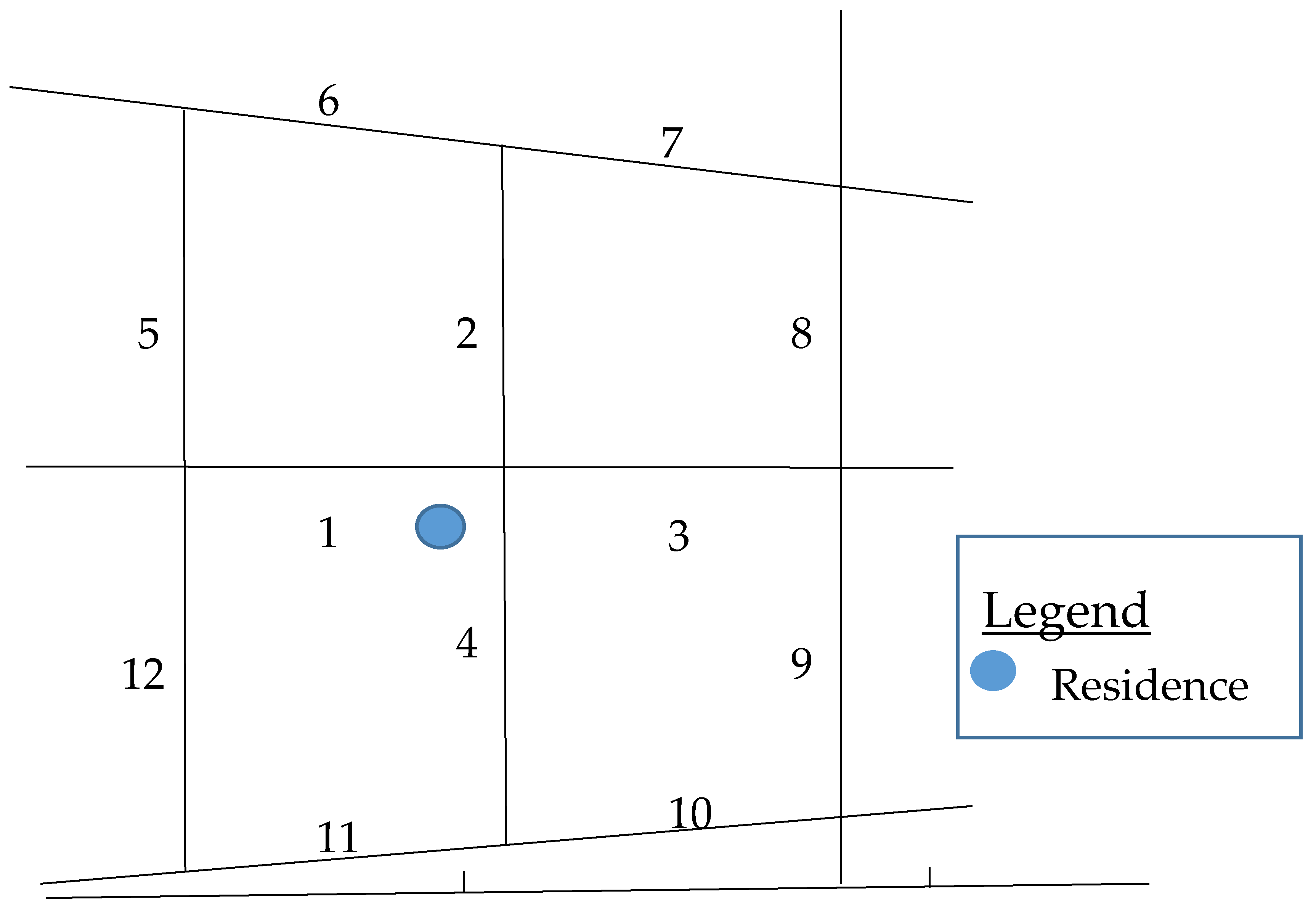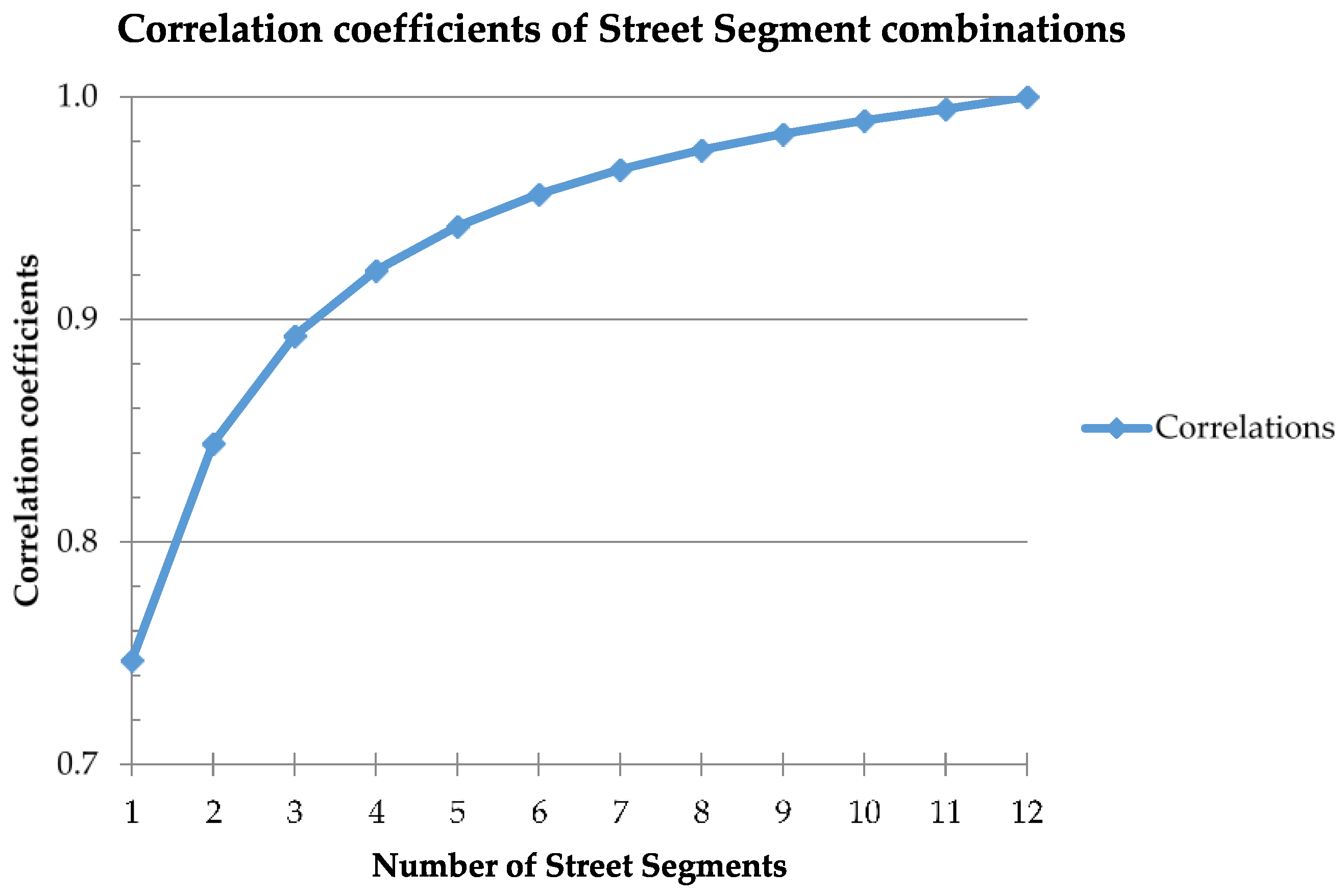Optimizing Scoring and Sampling Methods for Assessing Built Neighborhood Environment Quality in Residential Areas
Abstract
:1. Introduction
2. Materials and Methods
2.1. The Washington, D.C. Cardiovascular (CV) Health and Needs Assessment
2.2. The Active Neighborhood Checklist (the Checklist)
2.3. Scoring Protocol for the Checklist
2.4. Virtual Audit Training Procedure
2.5. Conducting Virtual Neighborhood Audits
2.6. Walk Score®
2.7. Statistical Analysis
2.8. Inter-Rater Reliability Coefficient
3. Results
4. Discussion
4.1. Strengths
4.2. Limitations
5. Conclusions
Supplementary Materials
Acknowledgments
Author Contributions
Conflicts of Interest
References
- Sallis, J.F.; Cervero, R.B.; Ascher, W.; Henderson, K.A.; Kraft, M.K. An Ecological Approach to Creating Active Living Communities. Annu. Rev. Public Health 2006, 27, 297–322. [Google Scholar] [CrossRef] [PubMed]
- Fleury, J.; Lee, S.M. The social ecological model and physical activity in African American women. Am. J. Community Psychol. 2006, 37, 129–140. [Google Scholar] [CrossRef] [PubMed]
- The Robert Wood Johnson Foundation. Where We Live Matters for Our Health: Neighborhoods and Health; The Robert Wood Johnson Foundation: Princeton, NJ, USA, 2008. [Google Scholar]
- Stokols, D. Establishing and Maintaining Healthy Environments: Toward a Social Ecology of Health Promotion. Am. Psychol. 1992, 47, 6–22. [Google Scholar] [CrossRef] [PubMed]
- Berke, E.M.; Koepsell, T.D.; Moudon, A.V.; Hoskins, R.E.; Larson, E.B. Association of the Built Environment with Physical Activity and Obesity in Older Persons. Am. J. Public Health 2007, 97, 486–492. [Google Scholar] [CrossRef] [PubMed]
- Frank, L.D.; Kerr, J.; Rosenberg, D.; King, A. Healthy aging and where you live: Community design relationships with physical activity and body weight in older Americans. J. Phys. Act. Health 2010, 7 (Suppl. 1), S82–S90. [Google Scholar] [CrossRef] [PubMed]
- Hirsch, J.A.; Moore, K.A.; Evenson, K.R.; Rodriguez, D.A.; Roux, A.V.D. Walk Score® and transit Score® and walking in the multi-ethnic study of atherosclerosis. Am. J. Prev. Med. 2013, 45, 158–166. [Google Scholar] [CrossRef] [PubMed]
- Sriram, U.; LaCroix, A.Z.; Barrington, W.E.; Corbie-Smith, G.; Garcia, L.; Going, S.B.; LaMonte, M.J.; Manson, J.A.E.; Sealy-Jefferson, S.; Stefanick, M.L.; et al. Neighborhood Walkability and Adiposity in the Women’s Health Initiative Cohort. Am. J. Prev. Med. 2016, 51, 722–730. [Google Scholar] [CrossRef] [PubMed]
- Creatore, M.I.; Glazier, R.H.; Moineddin, R.; Fazli, G.S.; Johns, A.; Gozdyra, P.; Matheson, F.I.; Kaufman-Shriqui, V.; Rosella, L.C.; Manuel, D.G.; et al. Association of Neighborhood Walkability With Change in Overweight, Obesity, and Diabetes. JAMA 2016, 315, 2211. [Google Scholar] [CrossRef] [PubMed]
- Blair, S.N. Physical inactivity: The biggest public health problem of the 21st century. Br. J. Sports Med. 2009, 43, 1–2. [Google Scholar] [PubMed]
- Ben-joseph, E.; Seung, J.; Cromley, E.K.; Laden, F.; Troped, P.J. Virtual and actual: Relative accuracy of on-site and web-based instruments in auditing the environment for physical activity. Health Place 2013, 19, 138–150. [Google Scholar] [CrossRef] [PubMed]
- Wilson, J.S.; Kelly, C.M.; Schootman, M.; Baker, E.A.; Banerjee, A.; Clennin, M.; Miller, D.K. Assessing the built environment using omnidirectional imagery. Am. J. Prev. Med. 2012, 42, 193–199. [Google Scholar] [CrossRef] [PubMed]
- Rundle, A.G.; Bader, M.D.M.; Richards, C.A.; Neckerman, K.M.; Teitler, J.O. Using Google Street View to Audit Neighborhood Environments. Am. J. Prev. Med. 2011, 40, 94–100. [Google Scholar] [CrossRef] [PubMed]
- Badland, H.M.; Opit, S.; Witten, K.; Kearns, R.A.; Mavoa, S. Can Virtual Streetscape Audits Reliably Replace Physical Streetscape Audits? J. Urban Health 2010, 87, 1007–1016. [Google Scholar] [CrossRef] [PubMed]
- Taylor, B.T.; Fernando, P.; Bauman, A.E.; Williamson, A.; Craig, J.C.; Redman, S. Measuring the quality of public open space using google earth. Am. J. Prev. Med. 2011, 40, 105–112. [Google Scholar] [CrossRef] [PubMed]
- Odgers, C.L.; Caspi, A.; Bates, C.J.; Sampson, R.J.; Moffitt, T.E. Systematic social observation of children’s neighborhoods using Google Street View: A reliable and cost-effective method. J. Child Psychol. Psychiatry Allied Discip. 2012, 53, 1009–1017. [Google Scholar] [CrossRef] [PubMed]
- Gullon, P.; Badland, H.M.; Alfayate, S.; Bilal, U.; Escobar, F.; Cebrecos, A.; Diez, J.; Franco, M. Assessing Walking and Cycling Environments in the Streets of Madrid: Comparing On-Field and Virtual Audits. J. Urban Health 2015, 92, 923–939. [Google Scholar] [CrossRef] [PubMed]
- Brownson, R.C.; Hoehner, C.M.; Day, K.; Forsyth, A.; Sallis, J.F. Measuring the Built Environment for Physical Activity. Am. J. Prev. Med. 2009, 36, S99–S123.e12. [Google Scholar] [CrossRef] [PubMed]
- Kelly, C.M.; Wilson, J.S.; Baker, E.A.; Miller, D.K.; Schootman, M. Using Google Street View to Audit the Built Environment: Inter-rater Reliability Results. Ann. Behav. Med. 2013, 45, 108–112. [Google Scholar] [CrossRef] [PubMed]
- Millstein, R.A.; Cain, K.L.; Sallis, J.F.; Conway, T.L.; Geremia, C.; Frank, L.D.; Chapman, J.; Van Dyck, D.; Dipzinski, L.R.; Kerr, J.; et al. Development, scoring, and reliability of the Microscale Audit of Pedestrian Streetscapes (MAPS). BMC Public Health 2013, 13, 403. [Google Scholar] [CrossRef] [PubMed]
- McMillan, T.E.; Cubbin, C.; Parmenter, B.; Medina, A.V.; Lee, R.E. Neighborhood sampling: How many streets must an auditor walk? Int. J. Behav. Nutr. Phys. Act. 2010, 7, 20. [Google Scholar] [CrossRef] [PubMed]
- Yingling, L.R.; Brooks, A.T.; Wallen, G.R.; Peters-Lawrence, M.; McClurkin, M.; Cooper-McCann, R.; Wiley, K.L.; Mitchell, V.; Saygbe, J.N.; Johnson, T.D.; et al. Community Engagement to Optimize the Use of Web-Based and Wearable Technology in a Cardiovascular Health and Needs Assessment Study: A Mixed Methods Approach. JMIR mHealth uHealth 2016, 4, e38. [Google Scholar] [CrossRef] [PubMed]
- Thomas, S.; Yingling, L.; Adu-Brimpong, J.; Mitchell, V.; Ayers, C.R.; Wallen, G.R.; Peters-Lawrence, M.; Brooks, A.T.; Sampson, D.M.; Wiley, K.L.; et al. Mobile Health Technology Can Objectively Capture Physical Activity (PA) Targets among African-American Women within Resource-Limited Communities—The Washington, D.C. Cardiovascular Health and Needs Assessment. J. Racial Ethn. Health Disparities 2016, 1–8. [Google Scholar] [CrossRef] [PubMed]
- Hoehner, C.M.; Ivy, A.; Brennan Ramirez, L.K.; Handy, S.; Brownson, R.C. Active neighborhood checklist: A user-friendly and reliable tool for assessing activity friendliness. Am. J. Health Promot. 2007, 21, 534–537. [Google Scholar] [CrossRef] [PubMed]
- Active Living Research Tools and Measures: Active Neighborhood Checklist. Available online: http://activelivingresearch.org/active-neighborhood-checklist (accessed on 3 March 2017).
- Kelly, C.; Wilson, J.S.; Schootman, M.; Clennin, M.; Baker, E.A.; Miller, D.K. The Built Environment Predicts Observed Physical Activity. Front. Public Health 2014, 2, 1–9. [Google Scholar] [CrossRef] [PubMed]
- Walk Score Walk Score. Available online: https://www.walkscore.com/ (accessed on 3 March 2017).
- Carr, L.J.; Dunsiger, S.I.; Marcus, B.H. Walk score as a global estimate of neighborhood walkability. Am. J. Prev. Med. 2010, 39, 460–463. [Google Scholar] [CrossRef] [PubMed]
- Carr, L.J.; Dunsiger, S.I.; Marcus, B.H. Validation of Walk Score for estimating access to walkable amenities. Br. J. Sports Med. 2011, 45, 1144–1148. [Google Scholar] [CrossRef] [PubMed]
- Duncan, D.T.; Aldstadt, J.; Whalen, J.; Melly, S.J.; Gortmaker, S.L. Validation of Walk Score® for estimating neighborhood walkability: An analysis of four US metropolitan areas. Int. J. Environ. Res. Public Health 2011, 8, 4160–4179. [Google Scholar] [CrossRef] [PubMed]
- Duncan, D.T.; Aldstadt, J.; Whalen, J.; Melly, S.J. Validation of Walk Scores and Transit Scores for estimating neighborhood walkability and transit availability: A small-area analysis. GeoJournal 2012, 78, 407–416. [Google Scholar] [CrossRef]
- Front Seat Walk Score Methodology. Available online: http://pubs.cedeus.cl/omeka/files/original/b6fa690993d59007784a7a26804d42be.pdf (accessed on 3 March 2017).
- Brown, S.C.; Pantin, H.; Lombard, J.; Toro, M.; Huang, S.; Plater-Zyberk, E.; Perrino, T.; Perez-Gomez, G.; Barrera-Allen, L.; Szapocznik, J. Walk score®: Associations with purposive walking in recent cuban immigrants. Am. J. Prev. Med. 2013, 45, 202–206. [Google Scholar] [CrossRef] [PubMed]
- Seymour, M.; Reynolds, K.D.; Wolch, J. Reliability of an audit tool for systematic assessment of urban alleyways. J. Phys. Act. Health 2010, 7, 214–223. [Google Scholar] [CrossRef] [PubMed]
- Hoehler, F.K. Bias and prevalence effects on kappa viewed in terms of sensitivity and specificity. J. Clin. Epidemiol. 2000, 53, 499–503. [Google Scholar] [CrossRef]
- Landis, J.R.; Koch, G.G. The Measurement of Observer Agreement for Categorical Data Published by International Biometric Society. Society 2008, 33, 159–174. [Google Scholar]
- Frackelton, A.; Grossman, A.; Castrillon, F.; Elango, V.; Guensler, R. Measuring Walkability : Development of an Automated Sidewalk Quality Assessment Tool. Suburb. Sustain. 2013, 1, 4. [Google Scholar] [CrossRef]
- Cain, K.L.; Millstein, R.A.; Sallis, J.F.; Conway, T.L.; Gavand, K.A.; Frank, L.D.; Saelens, B.E.; Geremia, C.M.; Chapman, J.; Adams, M.A.; et al. Contribution of streetscape audits to explanation of physical activity in four age groups based on the Microscale Audit of Pedestrian Streetscapes (MAPS). Soc. Sci. Med. 2014, 116, 82–92. [Google Scholar] [CrossRef] [PubMed]
- Cerin, E.; Chan, K.; Macfarlane, D.J.; Lee, K.; Lai, P. Objective assessment of walking environments in ultra-dense cities: Development and reliability of the Environment in Asia Scan Tool—Hong Kong version (EAST-HK). Health Place 2011, 17, 937–945. [Google Scholar] [CrossRef] [PubMed]
- Bethlehem, J.R.; Mackenbach, J.D.; Ben-rebah, M.; Compernolle, S.; Glonti, K.; Bárdos, H.; Rutter, H.R.; Charreire, H.; Oppert, J.; Brug, J.; et al. The SPOTLIGHT virtual audit tool: A valid and reliable tool to assess obesogenic characteristics of the built environment. Int. J. Health Geogr. 2014, 13, 52. [Google Scholar] [CrossRef] [PubMed]
- Charreire, H.; Mackenbach, J.D.; Ouasti, M.; Lakerveld, J.; Compernolle, S.; Ben-Rebah, M.; McKee, M.; Brug, J.; Rutter, H.; Oppert, J.-M. Using remote sensing to define environmental characteristics related to physical activity and dietary behaviours: A systematic review (the SPOTLIGHT project). Health Place 2014, 25, 1–9. [Google Scholar] [CrossRef] [PubMed]
- Dankwa-Mullan, I.; Prez-Stable, E. Addressing Health Disparities Is a Place-Based Issue. Am. J. Public Health 2016, 106, 637–639. [Google Scholar] [CrossRef] [PubMed]


| Audit Features | Maximum Score | Range of Observed Scores | Mean (SD) Scores |
|---|---|---|---|
| ‡ Per Street Segment | 87 | 10–47 | 29.36 (6.87) |
| * Audit Total (overall neighborhood) | 1044 | 172–475 | 352.32 (63.55) |
| A. Land-Use Type | 372 | 26–83 | 50.96 (14.51) |
| B. Public Transit | 48 | 0–15 | 2.73 (3.52) |
| C. Street Characteristic | 144 | 23–62 | 41.05 (10.07) |
| D. Quality of Environment | 144 | 39–97 | 65.98 (11.93) |
| E. Sidewalk Features | 336 | 53–258 | 191.60 (44.41) |
| Walk Score® | 100 | 0–91 | 46.65 (26.29) |
© 2017 by the authors. Licensee MDPI, Basel, Switzerland. This article is an open access article distributed under the terms and conditions of the Creative Commons Attribution (CC BY) license ( http://creativecommons.org/licenses/by/4.0/).
Share and Cite
Adu-Brimpong, J.; Coffey, N.; Ayers, C.; Berrigan, D.; Yingling, L.R.; Thomas, S.; Mitchell, V.; Ahuja, C.; Rivers, J.; Hartz, J.; et al. Optimizing Scoring and Sampling Methods for Assessing Built Neighborhood Environment Quality in Residential Areas. Int. J. Environ. Res. Public Health 2017, 14, 273. https://doi.org/10.3390/ijerph14030273
Adu-Brimpong J, Coffey N, Ayers C, Berrigan D, Yingling LR, Thomas S, Mitchell V, Ahuja C, Rivers J, Hartz J, et al. Optimizing Scoring and Sampling Methods for Assessing Built Neighborhood Environment Quality in Residential Areas. International Journal of Environmental Research and Public Health. 2017; 14(3):273. https://doi.org/10.3390/ijerph14030273
Chicago/Turabian StyleAdu-Brimpong, Joel, Nathan Coffey, Colby Ayers, David Berrigan, Leah R. Yingling, Samantha Thomas, Valerie Mitchell, Chaarushi Ahuja, Joshua Rivers, Jacob Hartz, and et al. 2017. "Optimizing Scoring and Sampling Methods for Assessing Built Neighborhood Environment Quality in Residential Areas" International Journal of Environmental Research and Public Health 14, no. 3: 273. https://doi.org/10.3390/ijerph14030273







